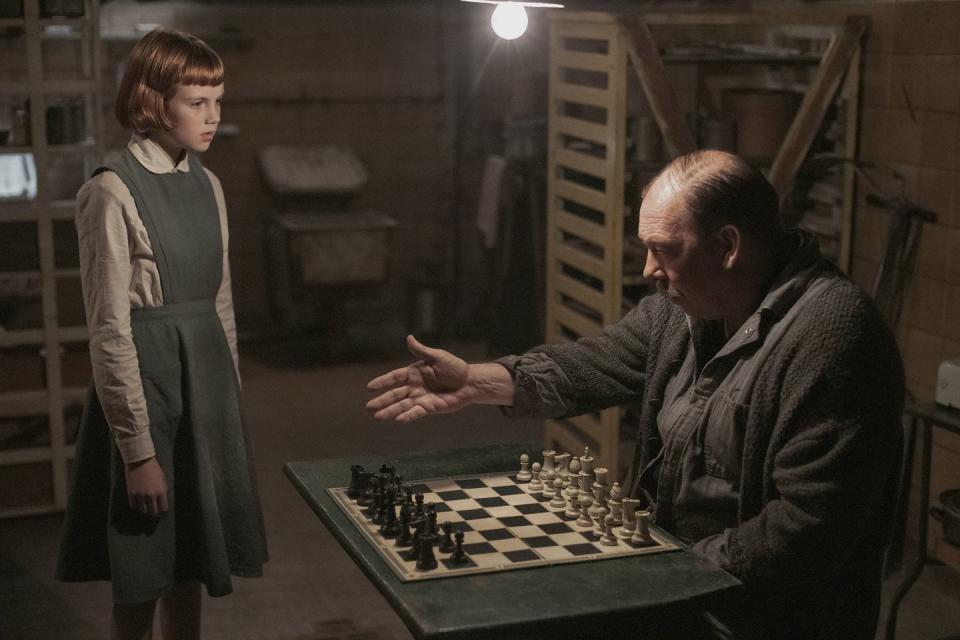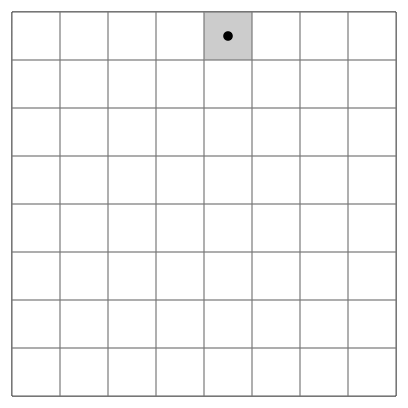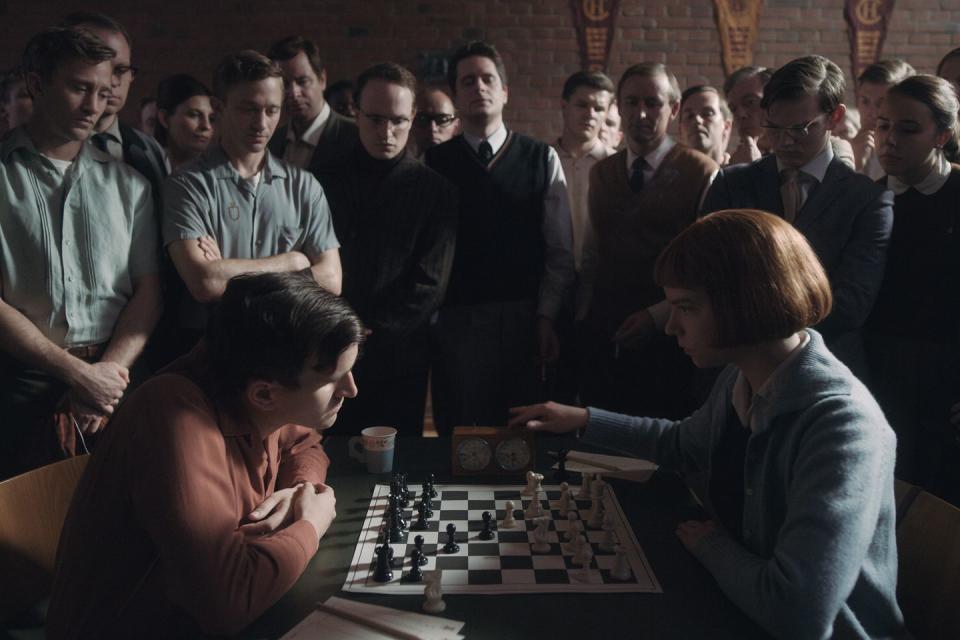Chess—and 'The Queen's Gambit'—Can Teach You a Strategy for Basically Anything
Netflix’s period-piece chess drama The Queen’s Gambit has made waves since premiering on October 23; as of press time, it's the most watched series on the streaming service.
There’s a wonderful meta quality to the series, which combines jaunty, colorful, interpersonal action with intensely dialed-in chess. The show uses chess as a plot driver as well as a metaphor; the game is packed with strategy and pattern recognition that echo out from almost every scene.
♙ You love badass games. So do we. Let's strategize together.
Using the show’s jargon as a jumping off point to study chess and strategy could help you think more clearly about problems and see patterns in the decisions you have to make, on and off the board.

Functionally, chess works like a complex Choose Your Own Adventure story. The structural facts make it a great analogy for skills used in programming, in particular. That’s one reason chess has been computerized for so long, and it’s probably why computers have been able to crack chess against humans.
The strategic broad strokes are the same as other competitive strategy games like Scrabble or even hearts, but the pieces and set of moves available are always the exact same with no element left to luck of the draw—something historians trace back to laws banning games of chance in the Muslim world of the Middle Ages.

A quick sketch of the basics: Chess players have eight pawns and four pairs of other pieces arranged symmetrically in two rows. The gameplay is dictated by each piece’s rules, which date back in some form for at least 1,500 years and maybe more. Chess gameplay can go nearly 6,000 moves, theoretically, but one of the shortest possible checkmates comes in just four moves. Chess has been turned into games like 1988’s Battle Chess as well as three, four, and even five dimensions in the 2020 game 5D Chess with Multiverse Time Travel.
♛ Essential Chess Sets and Accessories
The combinatorics of chess aren’t as simple as they seem because of the way the pieces interact and close each other out. There are 20 possible moves in the opening turn, and 400 possibilities for the second turn. But after that, it’s no longer just multiplying by 20. There are 5,362 maximum possible moves after three turns, 71,852 after four, and 822,518 after five.
Placement of knights, with their specified range of moves, has inspired a whole kind of brain teaser: the knight’s tour, of which there are a whopping—wait for it—26,534,728,821,064 possible versions on the board. (Thanks to Chess Maniac for the chess math.)

Programmer and chess master “Mansa Keita,” the pseudonym he uses for his popular Twitter account, thinks everyone should learn to play chess. “Beyond the constant challenge, there's also the fact that it's really a game where your losses and wins are true reflections of your own effort,” he tells Popular Mechanics. “It also forces your mind to question its assumptions and to rework those assumptions in the moment.”
I've gotten a draw against a chess Grandmaster and beaten an International Master, but as my wife will tell you, I also can't put together an IKEA chair with instructions.
The brain is fascinating thing. https://t.co/Kddb65ePE6— Dr. Mansa Keita (@rasmansa) October 20, 2020
“Chess is about knowledge, critical thinking and pattern recognition,” Keita says. “You know what's ‘bad’, so you find a way to avoid the bad things and get the good things. Two bishops, good. Doubled pawns, bad. It is fun, though, when you have to know the exceptions, like that doubled pawns in the center can be good by taking away key squares.”
Strip Keita’s specific chess references and this is the “best practices” lecture in an introductory coding course. Programmers even literally learn exception handling, which is an entire subfield by itself: predicting weird things that will try to endrun your code and break your program, and putting up defenses that route them back into the functional zone. Chess players also have styles: “My style is ‘controlled risk’, which is how I am in life, too,” Keita says.
Most chess software itself runs on a 25-year-old algorithm called Minimax, Keita explains, but the underlying mechanics are pretty simple. “It's just traveling along a tree and evaluating different positions,” he says. And, even for enthusiastic programmers, there’s no point reinventing the wheel.
“Most engines differ on how they evaluate—some may say a bishop is worth 3.25 and a knight 3, for example. Modern engines are really advanced, so you'd end up either being terrible, or copying the techniques of those engines,” says Keita.
Every day, you travel along a tree—we all do. A tree is a data structure representing branching choices. When you choose one option, others fall away. Keita plays a little bit with his young children, but his own chess career has already helped him be a better dad.
“There are definitely parenting lessons,” he says. “Chess helps me think my way through things methodically, and I can teach them that. Chess also teaches you how to handle failure, even when you do your best, sometimes it's just not enough. But, ultimately, your performance is on you. That's important, too.”

The combination of “no luck” and problem solving makes chess a great pedagogy tool, not just for learning the game or even just for STEM fields. The wrong opening move or other small error can doom your game, or it might be recoverable. Learning to see the difference is a key part of real ideas like fault tolerance and building grit. The University of Texas offers a two-course chess pedagogy unit that helps teachers introduce chess into curricula for critical thinking, literacy, and more.
Game developer Jon Ingold uses chess in a more literal way in his work as a founder of Inkle Studios, whose games like 2014’s 80 Days and this year’s Pendragon use hugely branching narratives to tell stories that are slightly different every time you play them. Ingold also wrote a climactic chess scene into his other 2020 project, Over the Alps. And while the game of chess might be at a different level, Ingold’s application and mindset share common themes with Keita’s.
“To be really good at chess, as I understand it, you have to start learning patterns, employing techniques, and having a high-level, encyclopedic overview,” Ingold tells Popular Mechanics. “I like to play it, not as a game of mastery, but as a game where you can have moments of cleverness and moments of dramatic, epic fail. A game of surprise and delight, but where everything that happens, happens for a reason.”
This is why it’s such a good narrative storytelling tool. “A lot of the time things go wrong and you think, in retrospect, I really should have seen that coming. But you don’t need to feel too bad about it, because the game is hard, and complex,” Ingold says. “Meanwhile, some other people approach life as a technical optimization exercise and they do very well ... and I don’t really understand those people very well at all!”
Pendragon is a combination of all of these lessons. It’s a medieval story—Uther Pendragon is King Arthur’s father—mixed with the animated pieces of iconic games like Battle Chess.
“We wanted the pieces to talk about the moves they were making as they moved, to worry about each other when they were put into danger - we wanted the player to feel guilty about sacrificing them!” Ingold says. “I’m interested in stories which arise from the moment to moment business of gameplay. Chess represents a kind of perfect problem for this kind of design; the game is so pure, and so abstract, that how could it create a story as you play?”
Learning the kind of chess player you are, from high knowledge and controlled risk to something a little more seat of the pants, is more effective than a Myers-Briggs test. And the only way to find that out—after bingeing The Queen's Gambit, of course—is to play some chess, which you can do online or with a willing foe at home.
“Every chess player has a style, and the more you learn, the more it gets to reflect,” Keita concludes. “Chess allows a lot of that individual creativity to be expressed in this little 8x8 world.”
Watch Next
You Might Also Like
